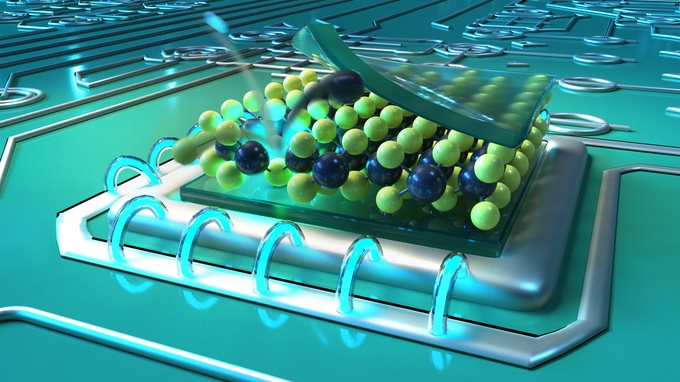Licht in der Nanowelt
Quantenlichtquellen ebnen den Weg zu optischen Schaltkreisen
2019-08-01 – News from the Physics Department

Bisherige Schaltkreise auf Chips bauen auf Elektronen als Informationsträger. Künftig könnten diese Aufgabe auch Photonen übernehmen, die in optischen Schaltkreisen mit Lichtgeschwindigkeit Informationen übermitteln. Als Grundbausteine solcher neuartigen Chips braucht man Quantenlichtquellen, die dann mit Quantenlichtwellenleitern und -detektoren verbunden werden.
Einem internationalen Team um die TUM-Physiker Alexander Holleitner und Jonathan Finley ist es nun gelungen, solche Quantenlichtquellen in atomar dünnen Materialschichten zu erzeugen und nanometergenau zu platzieren.
Erster Schritt zum Quantencomputer
„Dies stellt einen ersten wichtigen Schritt in Richtung optischer Quantencomputer dar“, sagt Julian Klein, Erstautor der Studie. „Denn für künftige Anwendungen müssen die Lichtquellen an photonische Schaltkreise, etwa an Wellenleiter, gekoppelt werden, um lichtbasierte Quantenberechnungen zu ermöglichen.“
Entscheidend ist dafür ist eine exakte und präzise steuerbare Platzierung der Lichtquellen. In konventionellen dreidimensionalen Materialien wie Diamant oder Silizium gibt es zwar auch aktive Quantenlichtquellen, allerdings lassen sie sich dort nicht präzise platzieren.
Deterministische Defekte
Als Ausgangsmaterial verwendeten die Physiker nun eine nur eine Atomlage dünne Schicht des Halbleiters Molybdändisulfid (MoS:sub:2). Diese bestrahlten sie mit einem Helium-Ionenstrahl, den sie auf Fläche von weniger als einem Nanometer fokussierten.
Um optisch aktive Defekte, die gewünschten Quantenlichtquellen, zu erzeugen, werden aus der Schicht Molybdän- oder Schwefel-Atome gezielt herausgelöst. Die Fehlstellen sind Fallen für sogenannte Exzitonen, Elektronen-Loch-Paare, die dann die gewünschten Photonen emittieren.
Technisch von zentraler Bedeutung war dafür das neue Helium-Ionen-Mikroskop am Zentrum für Nanotechnologie und Nanomaterialien des Walter Schottky-Instituts, mit dem sich solche Materialien mit einer bisher unerreichten örtlichen Auflösung bestrahlen lassen.
Auf dem Weg zu neuartigen Lichtquellen
Das Team entwickelte gemeinsam mit Theoretikern der TUM, der Max-Planck-Gesellschaft und der Universität Bremen ein Modell, um die beobachteten Energiezustände der Fehlstellen auch theoretisch zu beschreiben.
Zukünftig wollen die Forscher auch komplexere Lichtquellen-Muster erzeugen, etwa in lateralen zweidimensionalen Gitterstrukturen von Exzitonen, um so auch Vielteilchenphänomene oder exotische Materialeigenschaften zu untersuchen.
Dies ist die experimentelle Eintrittspforte in eine bislang nur theoretisch beschriebene Welt im Rahmen des sogenannten Bose-Hubbard-Modells, das versucht, komplexe Vorgänge in Festkörpern zu erfassen. Quantensensoren, Transistoren und sichere Verschlüsselung
Doch nicht nur in der Theorie könnte es Fortschritte geben, sondern auch hinsichtlich möglicher technischer Entwicklungen. Da den Lichtquellen immer der gleiche Defekt im Material zugrunde liegt, sind sie prinzipiell ununterscheidbar. Das ermöglicht Anwendungen, die auf dem quantenmechanischen Prinzip der Verschränkung basieren.
„Man kann unsere Quantenlichtquellen sehr elegant in photonische Schaltkreise integrieren“, sagt Klein. „Aufgrund der hohen Empfindlichkeit liessen sich beispielsweise für Smartphones Quanten-Sensoren bauen und extrem sichere Verschlüsselungstechnologien für die Datenübertragung entwickeln.“
Veröffentlichung
Weitere Informationen
Die Arbeiten wurden unterstützt durch die Deutsche Forschungsgemeinschaft (DFG) über die TUM International Graduate School of Science and Engineering (IGSSE), durch die Exzellenzcluster „Nanosystems Initiative Munich“ (NIM), „Munich Center for Quantum Science and Technology“ (MCQST) und „e-conversion“, das TUM-Institute for Advanced Study, das Doktorandenprogramm ExQM des Elite-Netzwerks von Bayern, durch die Europäische Union im Rahmen von Horizon 2020, das Förderprogramm Photonics Research Germany und die Bayerische Akademie der Wissenschaften.
Neben Wissenschaftlerinnen und Wissenschaftlern der Technischen Universität München waren Forschende des Max-Planck-Instituts für Quantenoptik (Garching), der Universität Bremen, der The State University of New York (Buffalo, USA) und des National Institute for Materials Science (Tsukuba, Japan) beteiligt.
Verwandte Meldungen
- Unsterbliche Quantenteilchen – 2019-06-27
- TUM mit vier Exzellenzclustern erfolgreich – 2018-09-27
- Auf dem Weg zur Terahertz-Elektronik – 2018-06-26
- Zentrum für Quantentechnik kommt nach Garching – 2018-04-30
- Nanolaser für die Informationstechnologie – 2016-02-11
- Quantencomputer aus gängigen Halbleitermaterialien – 2015-12-02
- Quantenströme: Oberflächlich und einzigartig – 2015-03-27
- Laserlicht aus Halbleiter-Nanodrähten – 2013-12-06
Kontakt
- Zentrum für Nanotechnologie und NanomaterialienTechnische Universität MünchenAm Coulombwall 4a, 85748 GarchingTel.: +49 89 289 11575E-mail: holleitner@wsi.tum.de
- Zentrum für Nanotechnologie und NanomaterialienTechnische Universität MünchenAm Coulombwall 4a, 85748 GarchingTel.: +49 89 289 12770E-Mail: jonathan.finley@wsi.tum.de